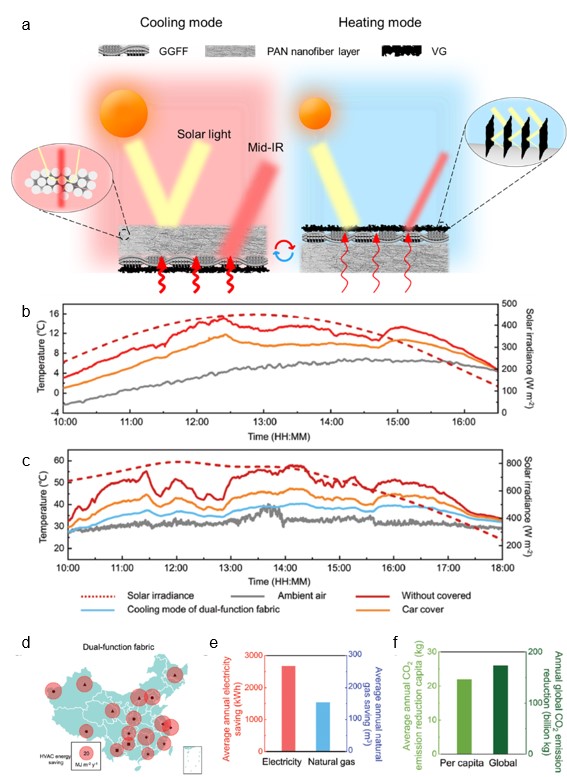Dual-function fabric for zero-energy thermal environmental management
Published in Materials and Mechanical Engineering

Active cooling and heating technologies based on fossil fuels for thermal environmental management have aggravated the energy crisis and greenhouse effect. Recently, passive radiative cooling and solar heating technologies have been developed with the objective of zero-energy-input temperature management. Notably, for most practical building thermal management, both indoor heating and cooling are required in most areas because of the highly dynamic weather conditions. Therefore, single-function roof coating materials with cooling- or heating-only functions cannot accomplish all-year round energy-efficient temperature adjustments. Hence, the simultaneous integration of radiative cooling and solar heating functions in one material is imperative for the dynamic modulation of the spatial temperature.
Recently, Yue Qi and Zhongfan Liu et al. in the College of Chemistry and Molecular Engineering at Peking University developed a dual-function fabric with both radiative cooling and solar heating functions (https://doi.org/10.1002/adma.202209897). The dual-function fabric was composed of vertical graphene (VG), graphene-skinned glass fiber fabric (GGFF), and polyacrylonitrile (PAN) nanofibers in a sandwich structure. In the cooling mode (left of Figure 1a), the GGFF with high infrared emissivity can emit the infrared radiation to the cold surrounding through the infrared, transparent PAN layer and the atmospheric transparency window. During the daytime, the PAN layer facing the surroundings presents high scattering in the solar spectrum following the Mie scattering theory to reduce the energy harvest, allowing the possibility of passive sub-ambient cooling. In the heating mode of the fabric (right of Figure 1a), solar energy is absorbed by the VG layer facing the external surrounding owing to its high absorptivity caused by multiple reflections between the graphene nanowalls. In addition, the PAN layer, having poor thermal conductivity, is in direct contact with the underlying base objects (such as the roof or wall), resulting in resistance in the heat transfer from the indoor space to the GGFF, thus reducing radiative heat loss.
The practical application of the dual-function fabric can be expanded to various scenarios such as use in car envelopes. The authors tested the outdoor heating and cooling performance of the dual-function fabric as a car envelope. In winter, dual-function fabric in heating mode can maintained the temperature in car’s internal space (Tin) ~2 ℃ higher than that covered by the commercial car cover, and ~9 ℃ higher than that of the surrounding air, indicating the superior heating capability of the fabric (Figure 1b). In summer, dual-function fabric in cooling mode can maintained Tin ~ 6 and ~16 ℃ lower than that of the commercial car cover and that without cover, respectively (Figure 1c). These results demonstrate the significant potential of the dual-function fabric for commercial application as car cover in various scenarios to maintain spatial temperature.
The authors applied EnergyPlus to calculate the year-round energy savings of the fabric as a roof coating to quantitatively predict the potential of the dual-function fabric for energy savings. As a result, the dual-function fabric showed the significant advantage in the year-round energy saving (~22.2 MJ m−2 y−1) (Figure 1d), which was ~15.5 and ~31.1 MJ m−2 y−1 higher than that of the cooling-only and heating-only fabrics, respectively. The energy savings of this building model were also converted into annual electricity and natural gas savings. Based on the results of calculation using EnergyPlus, an average of ~2673 kWh of electricity and ~154 m3 of natural gas can be saved for the modeled building (Figure 1e), which equates to ~2194 kg CO2 emission reduction for the entire building and ~21.9 kg per capita. The total annual global CO2 emission reduction is estimated to be ~173.7 MT based on the world population (Figure 1f), equating to an ~0.5% reduction, considering the ~34.8 billion metric tons of global CO2 emission per year.
 Figure 1. Dual-function fabric with both radiative cooling and solar heating functions. (a) Schematic of dual-function fabric used as a roof coating in cooling (left) and heating (right) modes. (b,c) Practical heating and cooling performances of the dual-function fabric in winter ((b), Beijing, January 7, 2022) and summer ((c), Beijing, June 17, 2022). (d) HVAC energy savings of building with dual-function fabric as roof coating in 16 cities in China. (e) Predicted average annual electricity and natural gas savings for the modeled building. (f) Predicted average annual CO2 emission reduction per capita and globally.
Figure 1. Dual-function fabric with both radiative cooling and solar heating functions. (a) Schematic of dual-function fabric used as a roof coating in cooling (left) and heating (right) modes. (b,c) Practical heating and cooling performances of the dual-function fabric in winter ((b), Beijing, January 7, 2022) and summer ((c), Beijing, June 17, 2022). (d) HVAC energy savings of building with dual-function fabric as roof coating in 16 cities in China. (e) Predicted average annual electricity and natural gas savings for the modeled building. (f) Predicted average annual CO2 emission reduction per capita and globally.



Please sign in or register for FREE
If you are a registered user on Research Communities by Springer Nature, please sign in